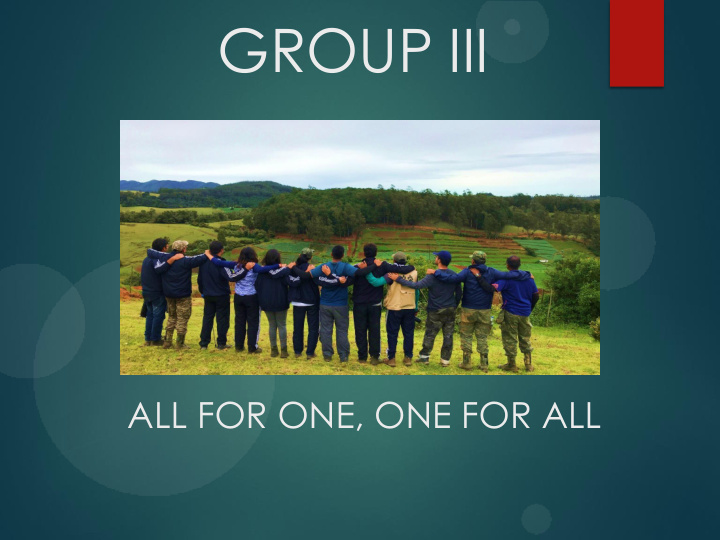



GROUP III ALL FOR ONE, ONE FOR ALL
Introduction Two roads diverged in a wood and I – I took the one less travelled by and that has made all the difference. - Robert Frost Trekking, the most exciting and awaited part of Foundation course • An experience to be remembered forever, where Officer Trainees get • the chance to forge bonds for a lifetime. Inculcate perseverance, empathy and esprit de corps. • Team: 26 members (19 males, 7 females), 10 different services, 16 • different states
GROUP MEMBERS 1. Aman Saxena- GL 14. Shrutimala 2. Kuldeep Singh- AGL 15. Ajey Singh 3. K. Apoorva Rao- Treasurer 16. Aman Singh Rathore 4. Rajnikant Mittal 17. Amit Goel 5. Mridul Kachawa 18. Vijaya Krishna Yadav 6. Kannan MVG 19. Md Moin Afaque 7. Varun Yadav 20. Chelsasini V 8. Kriti Pandey 21. Abhishek Kumar Agrawal 9. Pratyush Diwaker 22. Swati Singh 10. Rangaswamy E 23. Gokul Mahajan 11. Vaibhao Dahiwale 24. Neeraj Kumar Agarwal 12. Lavina Sinha 25. Amogh Gopinath 13. Vrinda Shukla 26. Naveen Garg * STF & Forest Guards: Mani, Hari, Vimal & Murugapandi
“All for One, One for All” The name describes the journey of 26 total strangers coming • together to form a single inseparable family, in a new and challenging environment. The family stood for each other through thick and thin. •
Trek Route
Group Activities Dumbcharades Cricket Bonfire Football Playing cards Mafia Antakshari Mimicry
Flora of the Nilgiris The flora comprises about 3,500 species of flowering plants. About 80 per cent of the flowering plants reported from the Western Ghats occur in the Nilgiri Biosphere Reserve. The Nilgiris, which support a variety of tree species, are threatened by monoculture of eucalyptus, wattle and blue gum and cultivation of food and cash crops. The sholas are being destroyed for plantations Besides sholas and grasslands, mosses were heavily seen especially when we trekked to Parson Valely from Sholur Kuranji flowers (from where the Nilgiris came to being called the blue mountain) were blooming and seen on road side while travelling from Naduvattam to Kargudi.
Wild Bamboo Nilgiri Tea Nilgiri Forests groves Plantations Kurunji Flowers Grasslands
Nilgiri Tea Mainly grown in the hills of the Nilgiris district of Tamil Nadu, besides Munnar and Central Travancore etc. GI Tagged under WIPO for its unique geographical origin. Expensive hand-sorted, full-leaf versions of the tea like the Orange Pekoe are highly sought after at international auctions Dark and aromatic. Also known as blue mountain tea. More than 50% of the harvest is exported. Tea Board of India have instigated programs to improve cultivation and harvest practices among small growers
Fauna of the Nilgiris Mudumalai Wild Tuskers Nilgiri Bisons National Park Sheep flocks of Deer Wild Boar Toda Herders
People and Culture Nilgiris has indigenous tribes and migrant workers. Tamil is the lingua franca of the region. Other local languages like Toda, Kota, Badaga and tribal languages are spoken. Malayalam and Kannada are also widely understood; Tribes include Todas 1. Kattu Nayakans 2. Kotas 3. Kurumbas 4. Paniyans 5. Irulas, who are the Particularly Vulnerable Tribal Groups (PVTG) and 6. Badagas 7.
A Toda temple en route The migrant tea workers are all women, Sholur to Parson’s Valley. Toda’s have a unique who work in the fields for long hours with custom, language and meagre pay. They served us delicious religion which are very tea on our way from Naduvattam to different from the other tribes. Kargudi They walk barefoot at all times and have temples and dwellings with buffalo motifs
Badagas migrated to the Nilgiris from the Mysore region in Karnataka, with their language being derived from Tamil- Kannada. They are the traditional landowners and cultivators in Nilgiris. Near Sholur, there are hamlets (called Hatti ) of Kannada speaking Gowdas who migrated to this region during Tipu Sultan’s reign.
Learnings Learning is the only thing the mind never exhausts, never fears and never regrets – LEONARDO DA VINCI It helped in promoting esprit de corps, and camaraderie among all of us It helped us in appreciating the beauty of nature, and thus getting more sensitized about environmental problems It helped us in realizing our physical and mental capabilities The journey of approx. 120 kms in 6 days helped each of us to become more self confident, and it helped us stretch our limits
Challenges The ultimate measure of a man is not where he stands in movement of comfort and convenience but where he stands at time of challenge and controversy. Cold weather with dense fog Animal encounters: Leech bites in dense forest of Nilgiri was effectively countered by application of salt and savlon soap. Chased by a lone tusker: along our way, we were chased by a wild elephant on the way from Naduvattam to Kargudi. Trekking in the slope and slippery areas led to blisters, muscle cramps and ankle twists. Scorching heat of the sun especially from Kargudi to Vazhaithottam
THANK YOU!
Recommend
More recommend